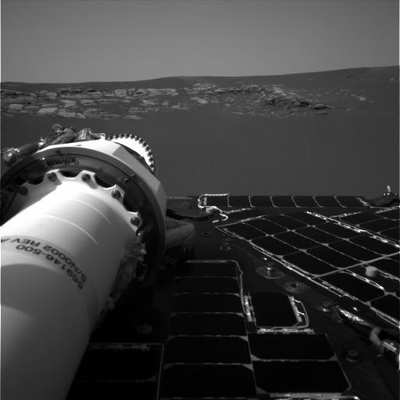Motor Stalling Earlier Than In Past
Could this mark the beginning of the end for one of NASA's
erstwhile Mars rovers? Well... don't bet on it, though both
intrepid Martian ground-crawlers are definitely showing signs of
their advanced age. NASA said Wednesday a small motor in the
robotic arm of Opportunity, that began stalling occasionally more
than two years ago, has become more troublesome recently.

Rover engineers at NASA's Jet Propulsion Laboratory are
diagnosing why the motor, one of five in the robotic arm, stalled
on April 14 after much less motion that day than in the case of
several earlier stalls. They are also examining whether the motor
can be used, and assessing the impact on Opportunity's work if the
motor were no longer usable.
The motor controls sideways motion at the shoulder joint of the
rover robotic arm. Other motors provide up-and-down motion at the
shoulder and maneuverability at the elbow and wrist. A turret at
the end of the arm has four tools that the arm places in contact
with rocks and soils to study their composition and texture.
"Even under the worst-case scenario for this motor, Opportunity
still has the capability to do some contact science with the arm,"
said JPL's John Callas, project manager for the twin rovers
Opportunity and Spirit. "The vehicle has quite a bit of versatility
to continue the high-priority investigations in Victoria Crater and
back out on the Meridiani plains after exiting the crater."
The performance of the motor in the past week is consistent with
increased resistance in the electrical circuit, such as from
degrading of wire in the winding, rather than a mechanical jam.
Additional tests are planned for checking whether the apparent
resistance is localized or intermittent.
Both rovers -- their official names are the Mars Exploration
Rovers Opportunity and Spirit -- landed on the Red Planet in
January 2004 to begin missions originally planned for three months.
They have continued operating for more than four years, though each
with some signs of aging.
Opportunity's balky shoulder motor began stalling occasionally
in November 2005. The motor could still be operated by applying
increased voltage. Engineers assessed it has an increased
likelihood of becoming unusable, however, so the team changed its
standard procedures for stowing and unstowing the arm.
Until then, on days when the arm would not be used, the team
kept it stowed, resting on a hook under the front of the rover
deck. Motion of the stall-prone shoulder motor is necessary to
unstow the arm, so if the motor were to become unusable with the
arm in the stowed position, the arm could not be deployed again.
With diminished confidence in the balky motor, the team began
unstowing the arm at the end of each day's drive rather than
leaving it stowed overnight. This keeps the arm available for use
even if the motor then stops working.

This spring, Opportunity is crossing an inner slope of Victoria
Crater to reach the base of a cliff portion of the crater rim, a
promontory called "Cape Verde." On April 14, Opportunity was
backing out of a sandy patch encountered on the path toward Cape
Verde from the area where the rover descended into the crater. As
usual, the commands included unstowing the arm at the end of the
day's short drive. The shoulder motor barely got the arm unstowed
before stalling.
"We'll hold off backing out of the sand until after we've
completed the diagnostic tests on the motor," Callas said. "The
rover is stable and safe in its current situation, and not under
any urgency. So we will take the time to act cautiously."
 ANN's Daily Aero-Term (04.24.24): Runway Lead-in Light System
ANN's Daily Aero-Term (04.24.24): Runway Lead-in Light System ANN's Daily Aero-Linx (04.24.24)
ANN's Daily Aero-Linx (04.24.24) Aero-FAQ: Dave Juwel's Aviation Marketing Stories -- ITBOA BNITBOB
Aero-FAQ: Dave Juwel's Aviation Marketing Stories -- ITBOA BNITBOB Classic Aero-TV: Best Seat in The House -- 'Inside' The AeroShell Aerobatic Team
Classic Aero-TV: Best Seat in The House -- 'Inside' The AeroShell Aerobatic Team Airborne Affordable Flyers 04.18.24: CarbonCub UL, Fisher, Affordable Flyer Expo
Airborne Affordable Flyers 04.18.24: CarbonCub UL, Fisher, Affordable Flyer Expo




